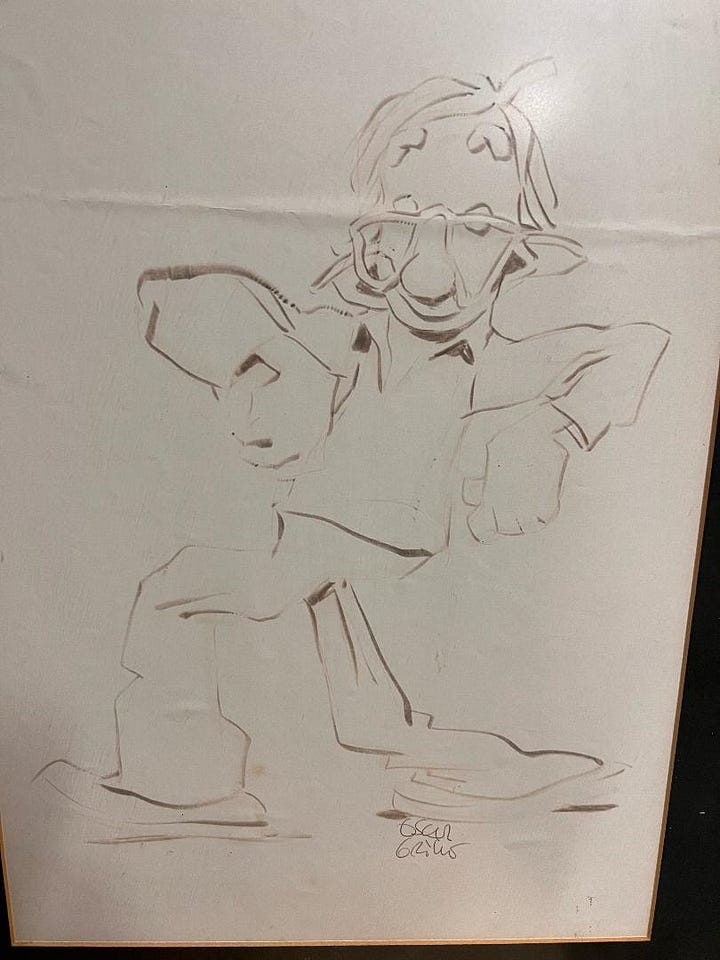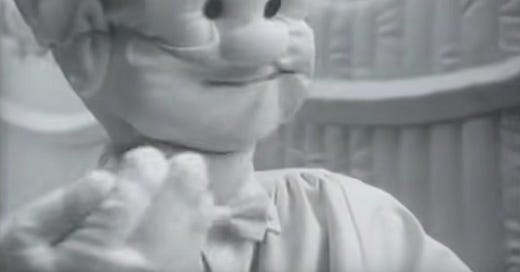"A Naive And Insane Charm" - The Untold Story Of Trebor's Mr Soft Adverts
An interview with Malcolm Green, the man behind the Trebor 'Mr Soft' adverts, on Steve Harley, Woody Allen and why the 37-year-old advert is remembered so fondly.
In all the time I wrote AdTurds (14 years and counting) I didn’t interview anyone. That was something I did in the day job and there was something liberating about just dashing off 500 words and sticking them up online. But in doing this newsletter I decided I can do more. There isn’t really anyone else doing this stuff. And there should be.
While I made my name on slating adverts I thought were awful, I can appreciate advertising as a unique art form that forces the creativity of a dozen people through a sieve, bottles it and then injects it into your mind in concentrated 30-second bursts. When it works, it can be brilliant, beautiful.
So today’s newsletter features Malcolm Green, a much storied writer, Director and Creative Director - and now an award-winning director whose film, Finding Abraham (about a group of young Israelis and Arabs taking a road trip together to explore peace, love and the chances of eternal friendship), has more gongs than Wynne Evans has sung ‘Go Compare’. What am I asking him about? The Trebor ‘Mr Soft’ Softmints adverts, naturally.
The newsletter format is the perfect medium to go deeper, to tell stories with real value that you won’t see anywhere else. If you enjoy this – and if you’d like to see more – please consider sharing and subscribing.
The Story Of Mr Soft
Oh Mr Soft… these adverts for Trebor Softmints and Trebor Softfruits (crispy on the outside, chewy on the inside) – featuring a man apparently made of cushions inhabiting a world on which everything is, well, soft to the peculiar tune fo Mr Soft by Steve Harley – have lived on in my mind across five decades. Not seen on television since 1995 they have nevertheless enjoyed a new lease of life due to Youtube, blogs and 40-something men with too much time on their hands (yes, that includes me).
I had intended to write in praise of these adverts, but in researching what little I could find about them I stumbled across the website of director Malcolm Green. Malcolm – along with collaborator Gary Betts – wrote the spots, featuring everyone’ favourite pillowy mint fanatic living in a cushioned grayscale world, back in the mid-80s.
35 years later we’re still talking what amounts to 60 seconds (a second spot featured Mr Soft on holiday, enjoying Soft Fruits and coming to grief courtesy of a crab) of a man in a suit advertising confectionary. An advert that inspired an Oasis song and a blockbuster film character’s walk. Bizarrely, Mr Soft became a cultural icon, despite having only 60 seconds of screentime devoted him nearly 40 years ago.
I wanted to find out why. Was it the amusing, pith-perfect riff on the original Steve Harley song? The sense of uncanny (my then-infant brother was driven to screaming terror by Mr Soft)? Or is it just a straight-up crackerjack concept? I wanted to know more, so I asked Malcolm, well, just about everything I could think of about how the ad came to be, whether that really is Steve Harley – and whatever happened to Mr Soft.


Not only that but for the first time you can see preliminary sketches of how artist Oscar Grillo envisaged the titular mascot. A melted Woody Allen isn’t far from the truth and would surely have inspired nightmares for a generation.
What follows is a comprehensive history of the Mr Soft Softmints adverts - and some details that could never have been guessed at.
Adturds: Where were you in your career when the Trebor adverts cropped up – and how did you end up working on them?
Malcom: This was pretty early in my career. I had moved to an agency called DDB with my creative partner Gary Betts (creative teams worked in pairs) and we were on a bit of a roll. We had managed to get some nice scripts and ads away for Volkswagen, including an award winning print ad around Beastie Boys fans nicking VW badges. The headline for that was ‘Who’s the cult who stole my badge?’ And the visual was a radiator grill without the VW.
We’d also started working on Trebor for some of their other brands, like Extra Strong Mints and seemed to have picked up a reputation as a bit of a wunderkind creative duo. Softmints was a problem brand for Trebor and wasn’t doing particularly well, so we were thrown the brief and tasked with doing some ‘famous’ advertising.
We also only had a day or two to come up with a campaign, which isn’t long. However, Gary and I had a creative process that seemed to always work really well (and fast) for us. This involved going for a long walk around the West End, in particular stopping at shops and stores whilst brainstorming ideas.
We didn’t take a notebook or pen. The thought was that if we’d forgotten an idea by the time we’d got back to the agency, it must have been shit. If we remembered it, there must be something in it.
Which came first? The track or the concept?
I think the track came first. I’d been a big fan of Cockney Rebel, particularly the ‘Psychomodo’ album on which Mr Soft appeared. I also loved ads that revolved around songs. The track leapt out whilst reading the brief and, on our walk, we had the whole re-write of the lyrics off pat. It was then a small step towards us thinking that it might be cool to create a character called Mr Soft who lived in this soft and chewy world.
Initially, we thought we might use animation, but then we remembered an exhibition by the pop-artist Claes Oldenburg, who made soft objects. So we decided to use that as a visual inspiration and do it for real.
We then worked with one of the great animators and cartoonists, Oscar Grillo, to help design the character. Our brief was Woody Allen! Funny thing was, Gary had drawn a very basic storyboard for one of the scripts and I somehow felt his interpretation was maybe better than Oscar’s (although now I’m not so sure).
We pulled in the brilliant movie model makers Asylum to make the character (and suit) as well as the soft world which was built on a really large stage at Shepperton Studios. At the same time, we hired a commercials director called Len Fulford, who was coming to the end of his career, to shoot the films. Peter Davison did the voiceovers; we’d already done a few VOs with him (as well as Hugh Laurie), so it felt a natural choice. He was always lovely, as were most of the actors I worked with.
Of course, running parallel, the client loved the ads. They were researched at storyboard stage with a resounding thumbs-up.
The idea was to re-record the track with Steve Harley himself (which was probably my ulterior motive in the first place). He wasn’t as popular at this time, so I was really keen to resurrect his career. However, by coincidence, Andrew Lloyd Webber chose him to be the voice of the Phantom on the initial album of Phantom of the Opera. Steve’s agent was convinced that Steve was going to get the gig for the stage show, so wouldn’t let him sing on our ad. However, he did give permission for the parody so we pulled in a session singer to imitate his voice. As it happens, a few weeks later, Michael Crawford got picked for the Phantom role, so Steve’s agent called back to see if he could sing the ad. Sadly, it was too late, and we’d got the finished track.
The record company did re-release the original version to tie in with the commercial and it did really well – also bringing Steve’s music to a new generation of fans. This included one Noel Gallagher who discovered Steve through the commercials and wrote the song ‘Shakermaker’ about the ads!
Mr Soft was amusingly described by the Daily Mash as a ‘boneless monster’. Were you aware at the time they might be received as particularly surreal – or even frightening?
We knew they were surreal. That was part of the intention. But I didn’t find out that some people were a bit frightened until much later. Incidentally, Jamie Dornan based his walk as Mr Grey in the film of ‘Fifty Shades…’ on our character.
What feedback did you get?
We won a ton of awards for the campaign, including a whole clutch at the British Television Advertising Awards, so we and the client were pretty chuffed about that. Plus the PR they received did do exactly what we were tasked with, which was to create a famous campaign.
In terms of success, we reversed the sales curve completely and ensured the survival of the brand. They were so successful that Trebor built on this and started introducing new flavours, [Trebor Softfruits], which we again did the ads for).
Any ideas where Mr Soft is now?
Someone nicked him from the agency!
What other campaigns are you most fond of?
Of my own, I’d have to say Walkers with Gary Lineker, for which I wrote the first four ads, the Dulux Dog singing a rewritten My Way, a Volkswagen commercial in black and white featuring the track ‘God Bless the Child’ and, of course, Howard from the Halifax adverts!
I really love the work I’m currently making, whether for and with brands or not. I feel the tools and technology we now have at our disposal are so exciting. I still also believe that sound is 51% of film and you can’t beat a great track.
What are your feelings about the Softmints adverts still commanding interest and fondness in 2023?
Maybe it isn’t a great reflection on the state of current advertising if people are still watching the old ones.
I’m quite baffled really. These were the days before CGI, so it’s so primitive compared to what can be done today. But I guess it still has a kind of naive and insane charm.
Thanks for reading AdTurds! Please subscribe for free to support my work and talk to more advertising people about things they did in the 80s.
Don’t forget to follow me on Facebook and let me know which advert has reduced you to a pathetic, dribbling mess this week. Or, conceivably, one you liked.
Many thanks for Adam and Farmersboy, who have pledged to support the newsletter with real cashmoney as and when I start a paid-for section. If that’s not for you then please sign up for a free subscription, or share the newsletter.





